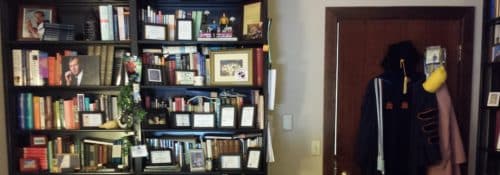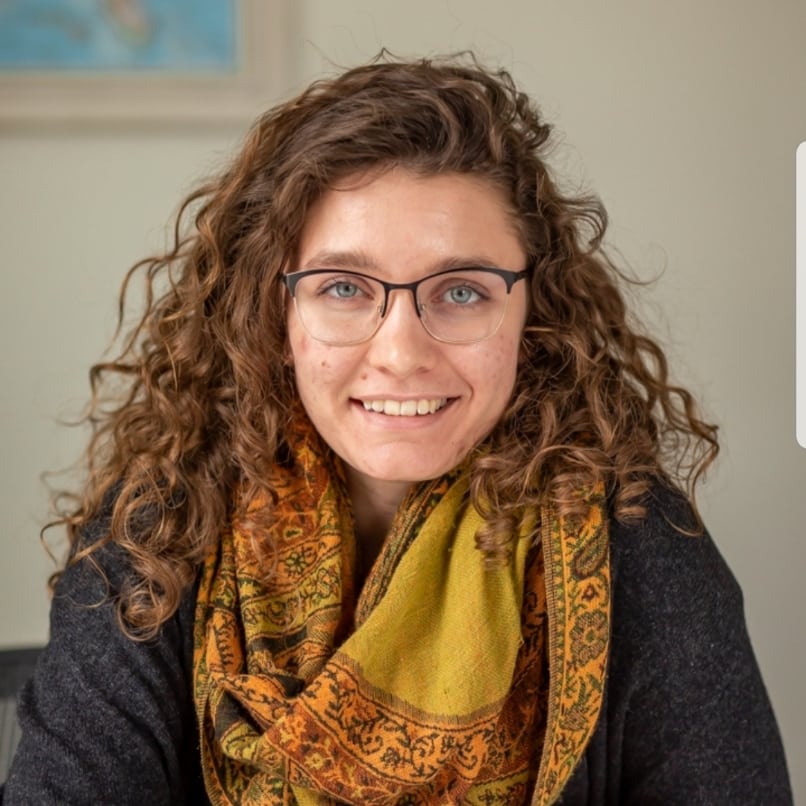
Office Hours Observations
Written by Marcella Brylski
Dr. Patricia Bart is a professor of English and a specialist in medieval literature. Dr. Charles Steele teaches in the economics department and is the Herman A. and Suzanne S. Dettwiler chair in economics. These things you can learn from a glance at the professor bios on Hillsdale’s website. What you might not know, however, is that Dr. Bart is a decided Trekkie, and Dr. Steele has run upwards of forty-seven ultramarathons.
There’s a lot more than test help or paper-writing advice to be had from visiting professors in their offices. Office hours can clue us into parts of our professors’ personal lives and their pasts, and so remind us that they are people with interesting and complex stories. They can even show us the humorous sides of professors, which I think is easy to forget in the middle of a busy semester.
For example, when you walk into Dr. Bart’s office, beware: you might catch the plague. Literally. She keeps a stuffed Black Plague bacillus on her shelf that she will sometimes throw at students when they visit her office. In addition to fun items like this, Dr. Bart’s office tells a rich story with an emphasis on her personal and academic history in order to remind herself why she does what she does at Hillsdale and how she got here. She keeps copies of her diplomas from not only her PhD program at the University of Virginia, but also from her masters, undergraduate, and even high school programs. These, Dr. Bart said, remind her to think of why she got these diplomas and that she owes a lot to the public school system she grew up in, which introduced her to Latin, history, and logic.
Dr. Bart also likes to display artifacts of pop culture throughout her office, both to throw students off a little and to remind them (and herself) of “the playfulness in life”—like the picture of the “cigarette smoking man” that occupies one of her upper shelves—and as pointers toward the “productive cultural phenomenon” that something like Star Trek inculcates, namely becoming invested in a story line and placing oneself in a moral world outside of our own—an important kind of “adult play,” as Dr. Bart called it. Star Trek memorabilia are scattered throughout her shelves, including a small crowd of action figures and a collection of Star Trek themed mugs.
In addition to these pop culture references, Dr. Bart keeps pictures of important people from her past. On one shelf, a picture of William E. Coles, Jr., one of her influential English professors, between paintings of Socrates and Dante, two other teachers who influenced her study of literature. On another, sepia-tone pictures of her great-great grandparents—one of her great-great grandmother in the cast of a play and one of her great-great grandfather standing on a giant magneto, a type of electric generator, in Duluth, MN. Each shelf, it seems, tells a different narrative from Dr. Bart’s life.
During my visit to Dr. Steele’s office, I learned about his career as an ultra-long-distance runner. The top of one of his filing cabinets is covered in plaques, medals, and ribbons from the races he’s won, including a medal for his dog (who often runs with him), a big wooden plaque that he earned for running the Le Grizz ultramarathon for ten years in a row (if he gets to twenty, he’ll go through a top-secret initiation ceremony and gain his own official nickname), and a medal from the race he recently ran while at an economics conference in the Bahamas. The Le Grizz ultramarathon takes up perhaps the most real estate in Dr. Steele’s office. He has a race poster from his first time running the race, the second year the race was put on, signed by Skookumtatum, a Le Grizz Ultramarathon legend, and the “Government Shutdown Award,” which he won for complaining most about a road closure that forced the race officials to change the route one year. (Dr. Steele stays incredibly active. He even has a list of upcoming races in the corner of one of his whiteboards!)
In addition to the evidence of his career as a runner, Dr. Steele’s office contains reminders of his time teaching in Eastern Europe. He has, for example, a traditional mace that would have been used by Ukrainian Cossack hitmen and a set of Russian stacking dolls that represent Moscow and its ring cities. The latter was a gift presented to him by some of his students before they took one of his exams (“They said it was ‘not a bribe,’” he told me).
Dr. Steele also has memorabilia from his father’s life, including the last letter his father wrote alongside a picture of his father and his father’s favorite dog; a drawing of the type of plane his father piloted in World War II; and the Navy-issue New Testament that bears his father’s inscription (alongside a warning to put your name and your name only, to avoid revealing too much should the New Testament be found by the enemy).
All of this is yet another reason (among many) that we should take advantage of the office hours that our professors generously provide. In addition to being fantastic academic resources and mentors, our professors have amazing stories to tell and experiences to share that we often leave unknown when we don’t visit them and, at least once in a while, let the space as well as the professor speak to us.
 Marcella Brylski, ’20, grew up in the great state of Minnesota, where she learned to love sunny fall days and distance running along the Mississippi River. She studies English and Greek at Hillsdale and takes great joy in unexpected conversations with friends, discovering contemporary poets, and unearthing treasures at the local thrift store.
Marcella Brylski, ’20, grew up in the great state of Minnesota, where she learned to love sunny fall days and distance running along the Mississippi River. She studies English and Greek at Hillsdale and takes great joy in unexpected conversations with friends, discovering contemporary poets, and unearthing treasures at the local thrift store.
Published in April 2019